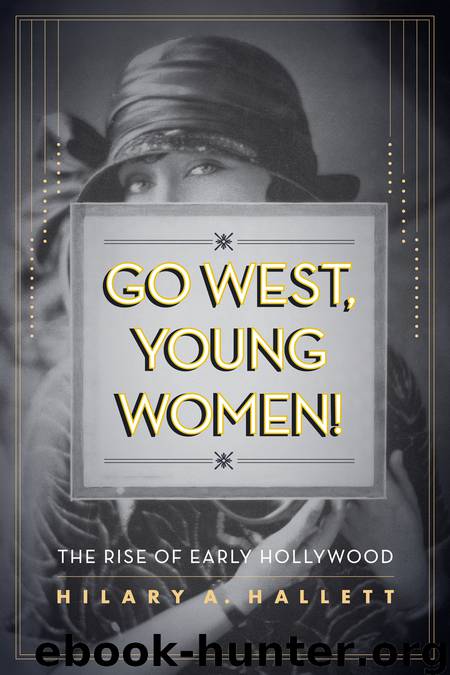Go West, Young Women! by Hilary Hallett

Author:Hilary Hallett
Language: eng
Format: epub
ISBN: 9780520274082
Publisher: University of California Press
CHAPTER 5
A Star Is Born
Rereading the “Fatty” Arbuckle Scandal
Years before the press used bohemian extra-girls and perverse movie producers to capture the appealing threat the industry posed, the Chicago American seized on another unconventional working girl to advertise the windy city's charms. “CHICAGO BEST CITY FOR GIRLS,” announced a headline in 1913, the same year Louella Parsons moved to the city on her own. A piece of shameless civic boosterism, the article interviewed a young model named Virginia Rappe to celebrate the unparalleled opportunities Chicago offered women. A large picture of “The Lonely Girl” sat beside the article. Its caption read “Be Original, Girls, and Grow Rich.” “They call Miss Rappe the ‘all aloney girl’ because she has had to make her way all alone in the world,” it explained. Being thrust onto her own devices at the age of sixteen had served Rappe well, by fostering the “courage and initiative” necessary to achieve her dreams. Indeed, just two years later, Rappe commanded a salary of “$4,000 a year” working “as a model in commercial lines.” Having traveled “all over the United States and a great part of Europe” before returning home, Rappe could attest to what made the city unique. “Chicago affords greater opportunity than any other town in the universe for the working girl,” she pronounced. The American ordered “aspiring neophytes” who feared competing with the city's “40,000 working sisters” to “now give heed” and “hearken to the voice of experience” by listening to what the “all aloney girl” had to say.1
According to Rappe's “philosophy” about how to get ahead, a working girl's imagination determined her chances in Chicago for success. “Every girl can't be a model, but every girl can be original,” she declared. Originality demanded rejecting the typical low-paying jobs prescribed for women. “Chicago has too many stenographers and office women,” she warned. Instead of “standing in lines for $6 a week jobs that are heart-breaking and demoralizing,” Rappe advised finding a means to take “part of the money all these business men and salaried workers take home with them and leave with their wives.” Such a task involved cultivating a flair for modern “feminine” passions, including shopping, socializing, fashion, and interior decorating—as had one friend who had turned “a dilettante devotion to art” into an $ 8,000-a-year career as “a flat-fixer” [interior decorator]. “If I were marked by smallpox to-morrow I'd turn ‘fixer’ for flat wives,” she assured readers. The invention of new professions, like personal shopper or party planner, by so many women in the “independent brigade” meant “we girls are in a far better position than the men are if only we could realize it.” Rappe justified her optimism by touting how Chicago nurtured “boldness” in working girls, making them “the last word in up-to-date femininity . . . superior in intelligence, adaptability and personal attractiveness.”2
Rappe's avowals about Chicago echoed a developing orthodoxy about the locus of opportunity for ambitious migrants. By the 1913 interview, many placed the best chance for class mobility and self-invention along cities’ anonymous, teeming streets.
Download
This site does not store any files on its server. We only index and link to content provided by other sites. Please contact the content providers to delete copyright contents if any and email us, we'll remove relevant links or contents immediately.
| African Americans | Civil War |
| Colonial Period | Immigrants |
| Revolution & Founding | State & Local |
Cat's cradle by Kurt Vonnegut(13894)
Pimp by Iceberg Slim(12946)
Underground: A Human History of the Worlds Beneath Our Feet by Will Hunt(11264)
4 3 2 1: A Novel by Paul Auster(11074)
The Radium Girls by Kate Moore(10915)
American History Stories, Volume III (Yesterday's Classics) by Pratt Mara L(4828)
Perfect Rhythm by Jae(4628)
Wiseguy by Nicholas Pileggi(4600)
The Fire Next Time by James Baldwin(4350)
Paper Towns by Green John(4177)
A Higher Loyalty: Truth, Lies, and Leadership by James Comey(4039)
Pale Blue Dot by Carl Sagan(4017)
The Mayflower and the Pilgrims' New World by Nathaniel Philbrick(3918)
The Doomsday Machine by Daniel Ellsberg(3737)
Too Much and Not the Mood by Durga Chew-Bose(3700)
Killers of the Flower Moon: The Osage Murders and the Birth of the FBI by David Grann(3622)
The Borden Murders by Sarah Miller(3594)
The Sympathizer by Viet Thanh Nguyen(3516)
Killing England by Bill O'Reilly(3461)
